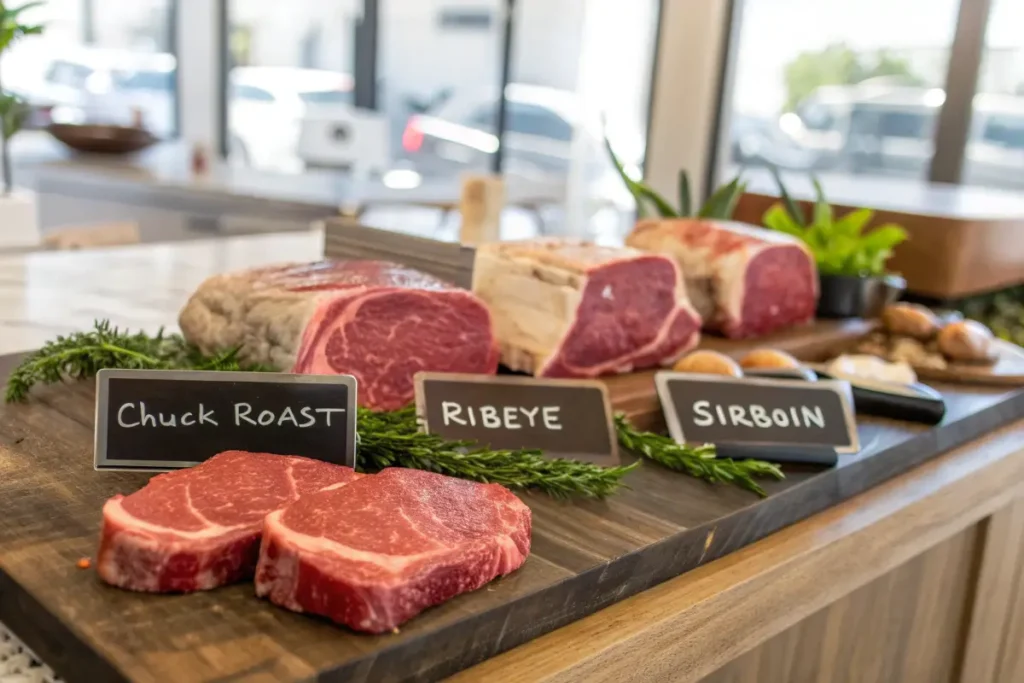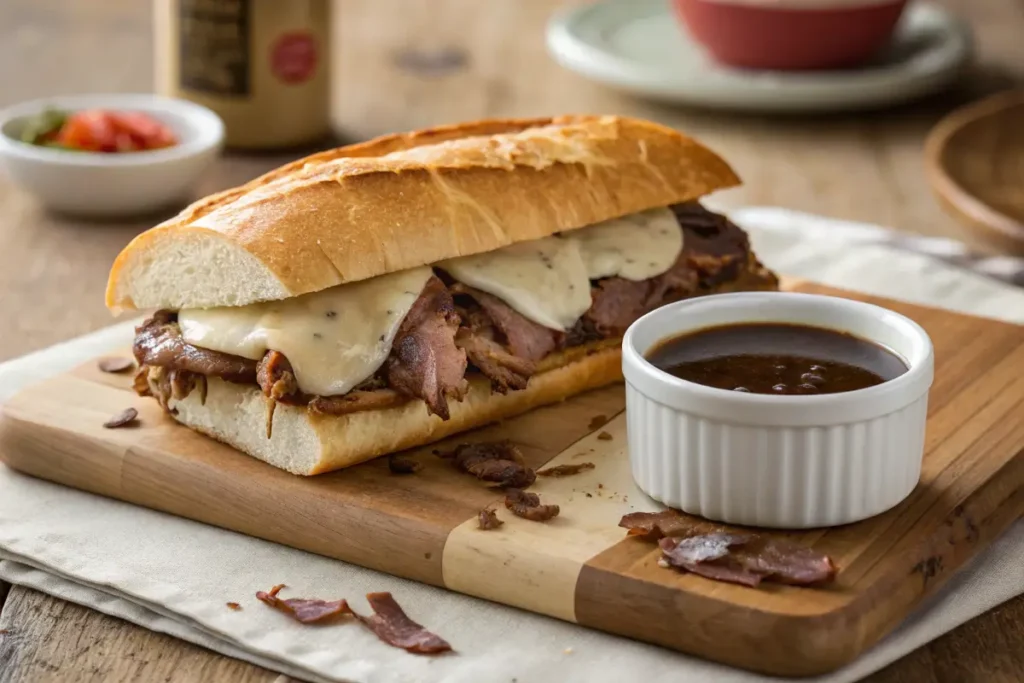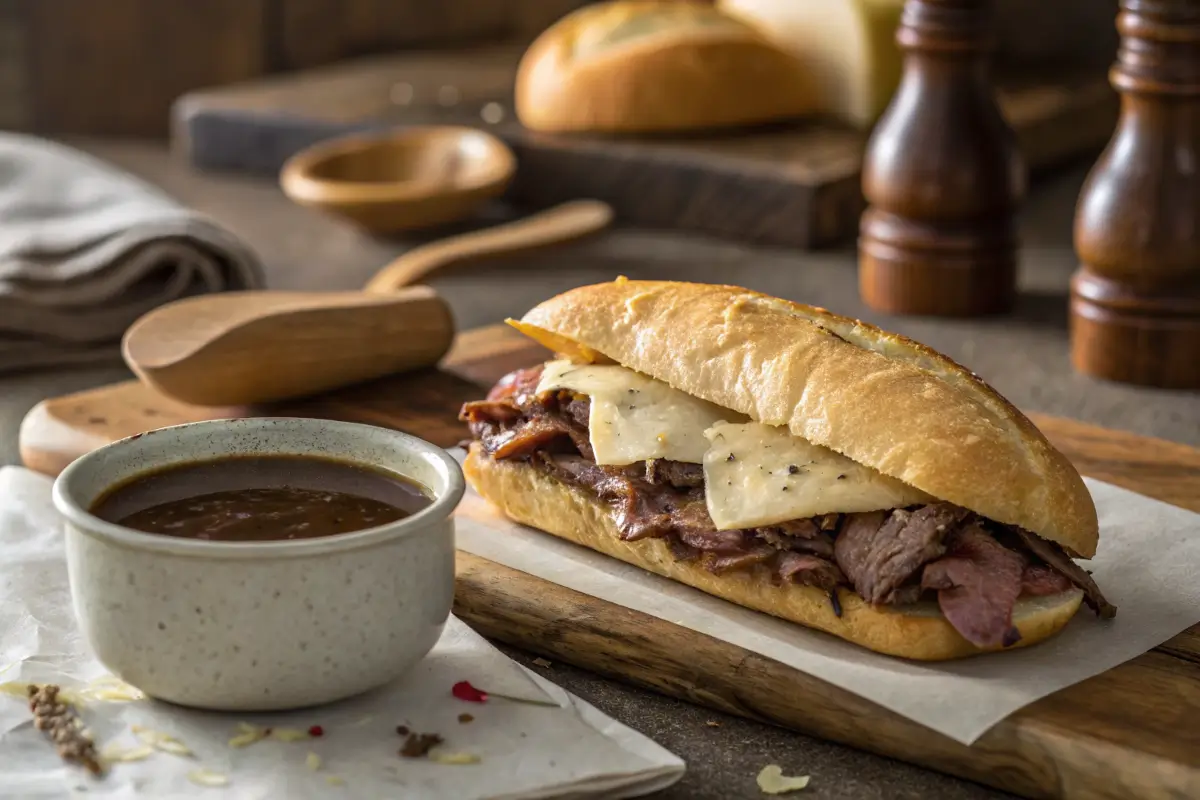When deciding on the best meat for French dip sandwiches, it’s crucial to prioritize tenderness and flavor.
French dip sandwiches are a savory favorite, featuring thinly sliced, tender beef layered on a crispy roll and dunked in flavorful au jus. The key to a great French dip lies in the cut of meat, cooking technique, and those mouthwatering drippings. This article dives into everything you need to know about making the perfect French dip sandwich, starting with the best cuts of meat and ending with tips for serving. Let’s begin!
Introduction to French Dip Sandwiches
What is a French Dip Sandwich?
The classic French dip sandwich is a hot, hearty dish made with tender slices of beef, served on a toasted French roll, and paired with a side of au jus for dipping. This flavorful sandwich combines the richness of slow-cooked beef with the satisfying crunch of toasted bread, making it a crowd-pleaser at any gathering.
The dipping sauce, or au jus, is crafted from the meat’s drippings, creating a broth bursting with beefy goodness. Whether served plain or topped with melted cheese like provolone or Swiss, this sandwich is as versatile as it is delicious.
Brief History of the French Dip
Surprisingly, the French dip didn’t originate in France. It was first created in Los Angeles in the early 20th century. According to legend, Philippe Mathieu, a French immigrant and owner of Philippe the Original, accidentally dropped a sandwich roll into a pan of meat drippings. Instead of tossing it, he served the dipped sandwich, and the customer loved it! Thus, the French dip sandwich was born, blending culinary traditions and sheer luck into a timeless recipe.
Part 2: Choosing chuck roast, ribeye, or sirloin ensures you’re using the best meat for French dip sandwiches to achieve that perfect bite.

Key Characteristics of Good Meat for French Dip
When crafting a French dip sandwich, selecting the right meat is crucial. The ideal cut should be tender, flavorful, and rich in marbling. These qualities ensure that the beef stays juicy, even after slow cooking. Marbling, or the fat within the meat, melts during cooking, giving the meat its tender texture and mouthwatering flavor. Additionally, the meat should slice easily to create the classic thin layers that soak up the au jus.
Best Cuts of Meat: Chuck Roast, Ribeye, and Sirloin
Among the top choices, chuck roast is a favorite for its balance of fat and connective tissue. When cooked low and slow, this cut breaks down into tender, succulent slices. For a leaner yet flavorful option, sirloin works well, providing a meaty texture without excess fat. Meanwhile, ribeye offers a luxurious, buttery flavor, perfect for elevating a simple French dip. Each cut has its unique benefits, so the choice depends on your taste and texture preferences.
Why Marbling and Tenderness Matter
Marbling is more than just visual appeal; it enhances the beef’s flavor and juiciness. During the slow cooking process, the fat renders, infusing the meat with a rich, beefy taste. This characteristic is why cuts like chuck roast and ribeye are highly recommended for French dip sandwiches. Without sufficient marbling, the meat might turn out dry, diminishing the sandwich’s overall quality.
For more tips on preparing tender beef, visit How to Make Leftover Steak Tender.
Cooking Methods for French Dip Meat
Slow Cooker Method for Perfectly Tender Beef
The slow cooker is the go-to appliance for achieving tender, juicy meat. It allows the beef to cook gently over several hours, breaking down tough fibers and resulting in melt-in-your-mouth perfection. To prepare, sear the meat first to lock in its juices, then place it in the slow cooker with aromatic spices and broth. Let it simmer on low for 6-8 hours, and voilà—you’ve got beef ready for the perfect French dip.
Oven Roasting vs. Braising: Which is Better?
For those without a slow cooker, oven roasting or braising are excellent alternatives. Oven roasting, done at a low temperature, caramelizes the beef’s exterior while keeping the inside tender. Braising, on the other hand, involves simmering the meat in liquid, enhancing its flavor and tenderness. Both methods yield delicious results, but braising is particularly ideal for retaining moisture and creating a robust au jus.
Importance of Searing the Meat Before Cooking
Searing is a game-changer when preparing beef for French dip sandwiches. It locks in the juices, enhances the beef’s flavor, and creates a savory crust. Before slow cooking or braising, quickly brown the beef on all sides. This step not only boosts flavor but also ensures a richer, more appetizing au jus. Skipping this step could mean missing out on the deep, meaty notes that make French dips irresistible.
For more beef cooking techniques, check out What is the Best Way to Heat Up Leftover Steak?.
Preparing the Au Jus
What is Au Jus and Why is it Essential?
The secret sauce—literally—of a perfect French dip sandwich lies in the au jus. This savory, beefy dipping sauce enhances the sandwich’s flavor, transforming each bite into a burst of rich, juicy goodness. Au jus, meaning “with juice” in French, is made from the drippings of the beef. It’s packed with umami and adds a delectable layer of moisture and taste.
Classic Au Jus Recipe Ingredients and Tips
Creating a classic au jus is simple yet rewarding. The basic ingredients include beef drippings, beef consommé or broth, garlic, onion powder, and Worcestershire sauce. To deepen the flavor, consider adding a splash of red wine or soy sauce. Once combined, simmer the mixture over medium heat for 10–15 minutes to concentrate the flavors. For a thicker sauce, whisk in a small amount of cornstarch dissolved in water.
Alternative Broth Enhancers: Beef Consommé and Bouillon
If you’re short on drippings, don’t worry! Beef consommé or bouillon makes a fantastic substitute. These concentrated broth options deliver the rich, meaty flavor essential for an excellent au jus. When using bouillon, dissolve it in hot water and adjust the seasoning to prevent it from becoming overly salty. For even more depth, you can combine consommé with a splash of soy sauce or a bay leaf while simmering.
For more delicious beef recipes, check out our other articles at Tester Recipes.
Assembling the Perfect French Dip Sandwich
Choosing the Right Bread: Hoagies, Baguettes, and Rolls
When building a French dip sandwich, the bread plays a pivotal role. You need something sturdy yet soft enough to absorb the au jus without falling apart. Hoagie rolls, French baguettes, and sub rolls are popular choices. Hoagies offer a soft, pillowy texture, while baguettes provide a slightly crunchy crust. For a classic touch, lightly toast the bread to add an extra layer of flavor and durability.

Adding Cheese: Provolone, Swiss, and More
Although cheese is optional, it elevates the sandwich to a new level. Provolone is a favorite for its mild, creamy flavor that complements the beef without overpowering it. Swiss cheese adds a nutty, slightly tangy note, while mozzarella offers a gooey, melty texture. Whatever your preference, layering cheese over the beef and melting it in the oven creates a sandwich that’s both hearty and satisfying.
Tips for Dipping Without Soggy Sandwiches
Ah, the joy of dipping! To ensure your sandwich doesn’t turn into a soggy mess, dip only the edges of the bread or take quick, controlled dips. This way, you’ll enjoy the rich flavor of the au jus without sacrificing the sandwich’s structure. Additionally, serve the au jus in a separate dish to give diners control over how much to dip.
While Philly cheesesteak uses a different preparation method, its beef still highlights the importance of selecting the best meat for French dip sandwiches.
Philly Cheesesteak vs. French Dip
At first glance, a Philly cheesesteak and a French dip sandwich might seem similar, but they’re worlds apart in flavor and preparation. While the French dip focuses on thinly sliced beef dipped in flavorful au jus, the Philly cheesesteak typically features shaved steak sautéed with onions, peppers, and gooey cheese like provolone or Cheez Whiz. The French dip’s simplicity allows the beef and dipping sauce to shine, making the choice of beef—like chuck roast or ribeye—even more critical.
Adding Vegetables: Onions, Peppers, and Mushrooms
Though traditional French dip sandwiches keep it simple, adding sautéed vegetables can elevate the dish. Caramelized onions bring sweetness, while bell peppers and mushrooms add depth and texture. These extras not only enhance the flavor but also introduce a satisfying crunch and variety. If you’re feeling adventurous, try layering roasted garlic or pickled jalapeños for a bolder bite.
French Dip Sliders for Parties
Hosting a party? French dip sliders are a fun, bite-sized twist on the classic sandwich. Use small rolls, like Hawaiian sweet rolls, to create mini versions. These sliders are easy to assemble, quick to bake, and perfect for dipping. They’re also a great way to experiment with different cheese options and toppings without committing to a full-sized sandwich.
FAQs About French Dip Sandwiches
What Other Cuts of Meat Can I Use?
While chuck roast and ribeye are top choices for French dip sandwiches, other cuts like brisket or top round can also work well. These cuts offer a slightly leaner texture but still deliver plenty of flavor, especially when cooked low and slow. Ultimately, when asking what cut of meat is good for French dip sandwiches, focus on tenderness and marbling for the best results.
Can French Dip Sandwiches Be Made in Advance?
Yes! French dip sandwiches are highly versatile and can be prepped ahead of time. Cook the beef, refrigerate it in its juices, and reheat it when you’re ready to serve. This method not only saves time but also allows the flavors to deepen overnight. Just be sure to store the bread separately to avoid sogginess.
How Do I Reheat French Dip Without Drying It Out?
To keep the beef moist and flavorful during reheating, add a bit of the reserved au jus. Whether you’re using a slow cooker, stovetop, or microwave, low heat is key. This gentle approach ensures the beef stays tender and delicious without losing its juicy texture.
What to Serve With French Dip Sandwiches?
A French dip sandwich pairs wonderfully with a variety of sides. Consider serving it with crispy fries, a fresh coleslaw, or even a warm bowl of potato soup. These accompaniments balance the sandwich’s richness and make for a hearty, satisfying meal. For a lighter option, a simple green salad with a tangy vinaigrette works perfectly.
Conclusion and Final Tips
Recap of Key Points
Creating the perfect French dip sandwich requires attention to detail, starting with the meat. The answer to what cut of meat is good for French dip sandwiches lies in selecting tender, well-marbled cuts like chuck roast, ribeye, or sirloin. These cuts, when cooked properly, deliver juicy, flavorful results that soak up the au jus beautifully. Additionally, pairing your beef with the right bread and cheese, and perfecting the au jus, ensures a sandwich that’s both hearty and irresistible.
Encouragement to Experiment with Variations
While the classic French dip is a masterpiece on its own, don’t shy away from adding your own twist. Whether it’s experimenting with different cuts of meat, trying new cheeses, or adding sautéed vegetables, the possibilities are endless. You can even explore unique serving styles, like sliders or open-faced sandwiches. Remember, the goal is to craft a sandwich that satisfies your taste buds and elevates your dining experience.
Final Thoughts and Takeaways
Crafting a French dip sandwich is as much about personal preference as it is about tradition. From choosing the best cut of beef to customizing toppings and sides, every element contributes to a delicious result. So the next time someone asks, what cut of meat is good for French dip sandwiches?, you’ll not only have the answer but also the confidence to create a sandwich that’s truly unforgettable.
For more mouthwatering recipes and culinary tips, check out our other articles at Tester Recipes. Happy cooking!

